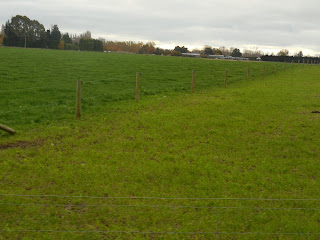Farm Stay and Queenstown
Today we had the morning to do as we wished with just one stipulation, be out of the hotel by 10am. Pat, Ashley, Tasha, and Lauren went out in search of a spa, but all of the spa's were booked for high schooler's event. So they just ventured out into the downtown Queenstown area. Dana found new adventures and journaled, as per usual sitting by the lake. Colton, Taylor, Cody, and Derek climbed up a mountain that took them about a hour. Wyatt went to a scenic overlook. The group all met at the hotel that was atop of cardiac hill (a very steep incline inducing cardiac stress).
Then we broke off into 3 groups to go to farm stays. One of the groups stayed with Murray and Joyce Turner. Dana, Tasha, Lauren, Sophie, and Grant stayed at the dairy and sheep farm. Murray had lived on his farm since he was two and he has now retired and is leasing out the farm to his nephew and another farmer. We received a tour of the farm, seeing Friesian cows being milked with a rotary milking system. We also saw the post dip that was automated when the cups had came off. Then we ventured into a paddock that was being used to winterize cattle. There was 200 in a 2 acre area feeding off of barley silage. After that we saw different paddocks for grazing and where they keep many of the sheep.There was also a tour of the wool shed, and they had 4 shearers and they harvest the wool twice a year. Murray was also a John Deere man! Joyce and Murray showed us great hospitality and we all had a great time drinking tea and watching some of the different sports like net ball that is area's ( Netball!) being played, and even a episode of the notorious Country Calendar. Lauren found out that the cooking book she bought, Edmunds (akin to Julia Child in popularity), contained the pavlova recipe that we had for desert. Dana even got a chance to conquer her crippling fear of 3D puzzles, her family would be very proud.
Wyatt, Ken, Julie and I (Taylor) stayed at Fergus and Lynn Collie's sheep farm for our farm stay. After a little searching around town we found the right spot to be picked up by Fergus and headed to his farm just outside Otautau. Our first stop was at a neighboring dairy barn where we got to see our first rotary milker in use which really helped me fully understand the how it actually worked. From there we took a driving tour of his beautiful farm, we even got to get our hands and shoes, dirty by helping herd some sheep to a different paddock. When the last stray sheep was in the paddock we went back to the house to warm up by the fire with a nice cup of tea while we talked about everything from our childhoods on the farm to politics. After an amazing meal and watching New Zealand's Young Farmer club, which is kinda like the FFA competition, we called it a night.
The final group Cody, Colten, Derek, Ashley, and Pat stayed with Bruce and Annabel Russell. We were picked up on the side of the road by Bruce who brought us to his son Brian's deer farm. When we showed up to the farm, Brian was out in the truck feeding the deer, so we went out and met him in the field. When we got out there we noticed that a little kid was driving the truck, he was four years old, waving at us while standing on the seat steering. Then they gave us a tour where the little four year told us everything we needed to know about the farm. Even though we couldn't understand him half of the time, we learned a lot from him. He told us how they had a possum paddock where a week ago people came in and trapped 700 possum. Then we went and saw the trophy deer that they were raising, which scored over 300. Unfortunately it wasn't large enough for the buyers, so they will try again next year. After visiting Brian's farm we went to Bruce's house were we met Annabel. She offered us tea and muffins and then showed us to our rooms. After tea, we went out and toured Bruce's farm. He brought us up through the high county using little farm trails which were a little scary for some of us flat landers. We drove through streams, along side mountains, and even over top of the mountain, all of which was really exciting. When we arrived back at the house there was a plate full of snacks that we munched on while getting to know each other and our hosts. Luckily it was then time to eat dinner. We had an amazing lamb roast with veggies and potatoes. After dinner we talked some more and then called it a night.

























































